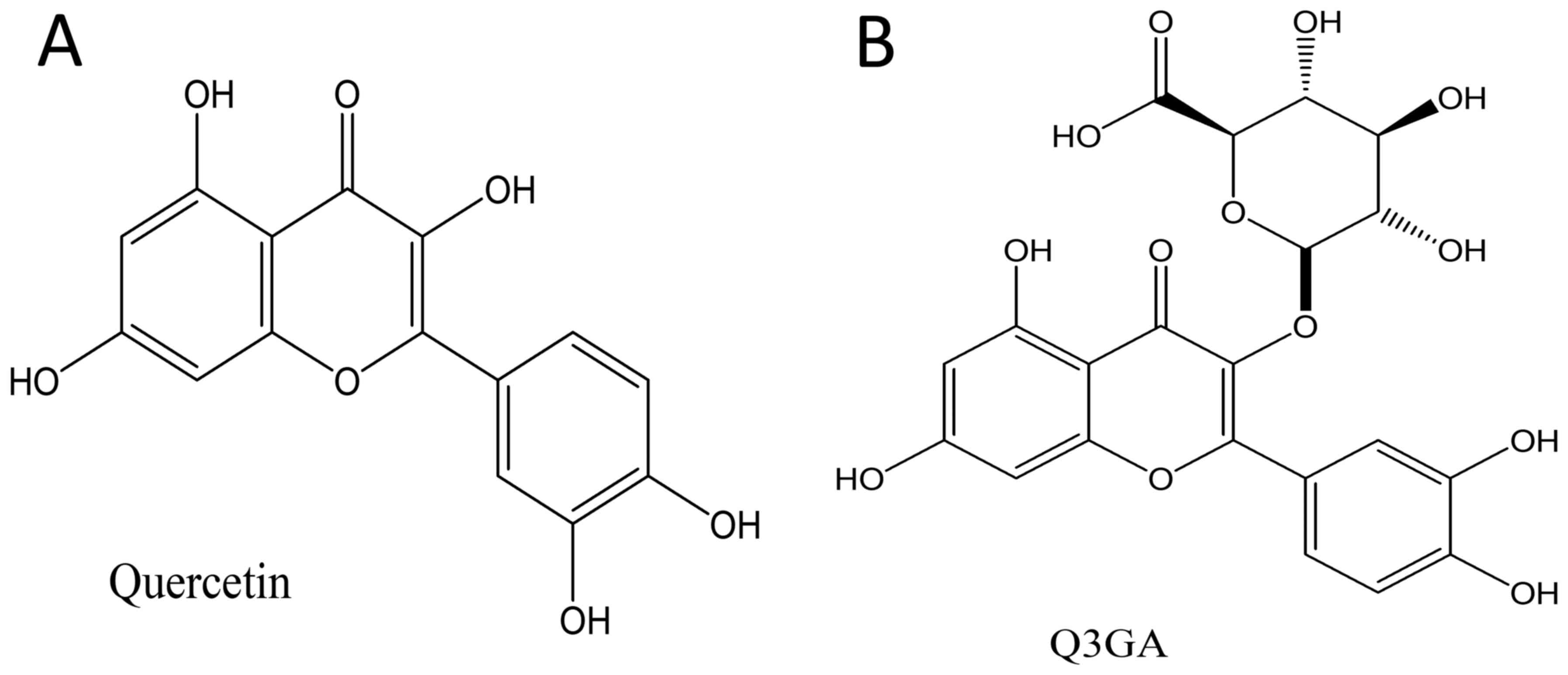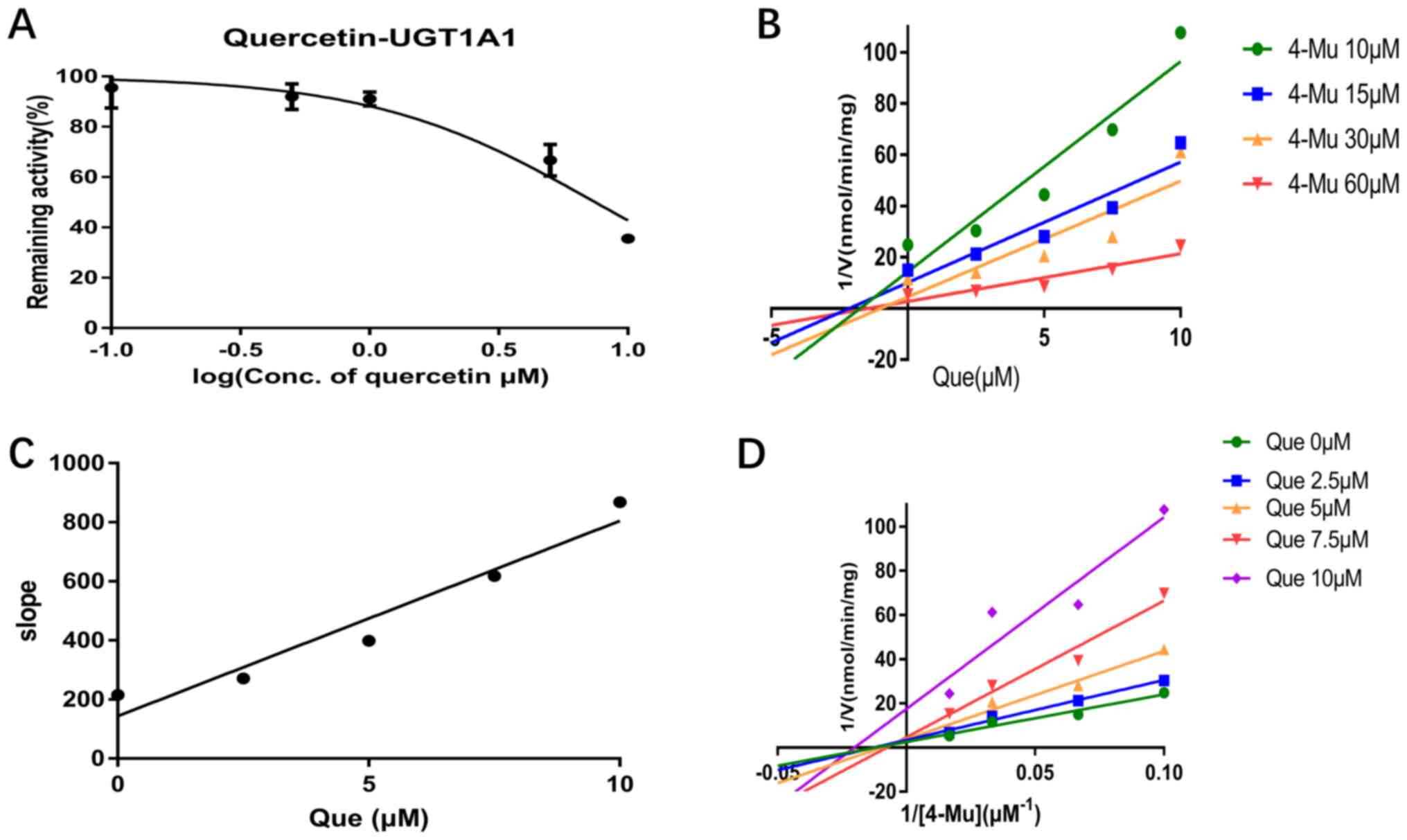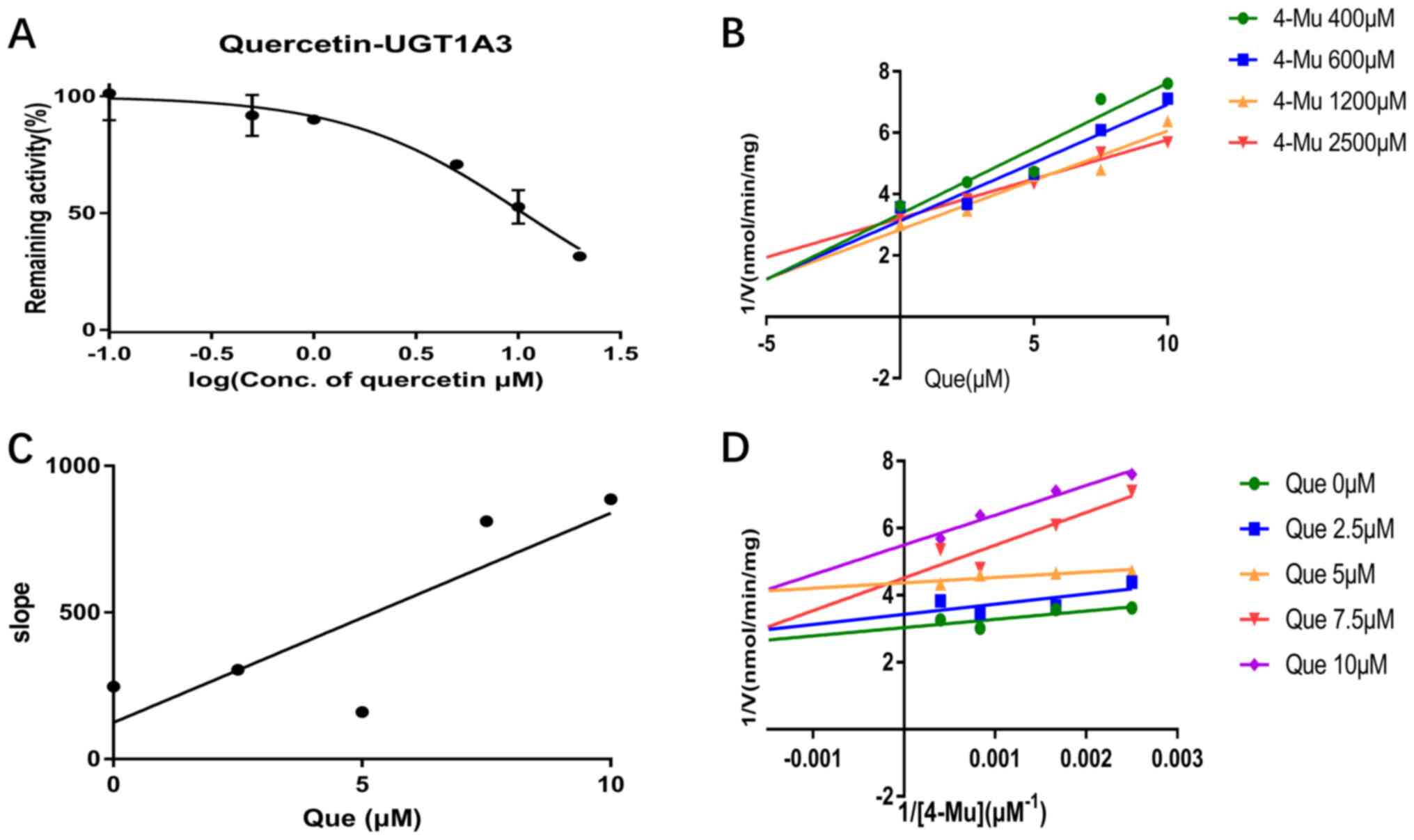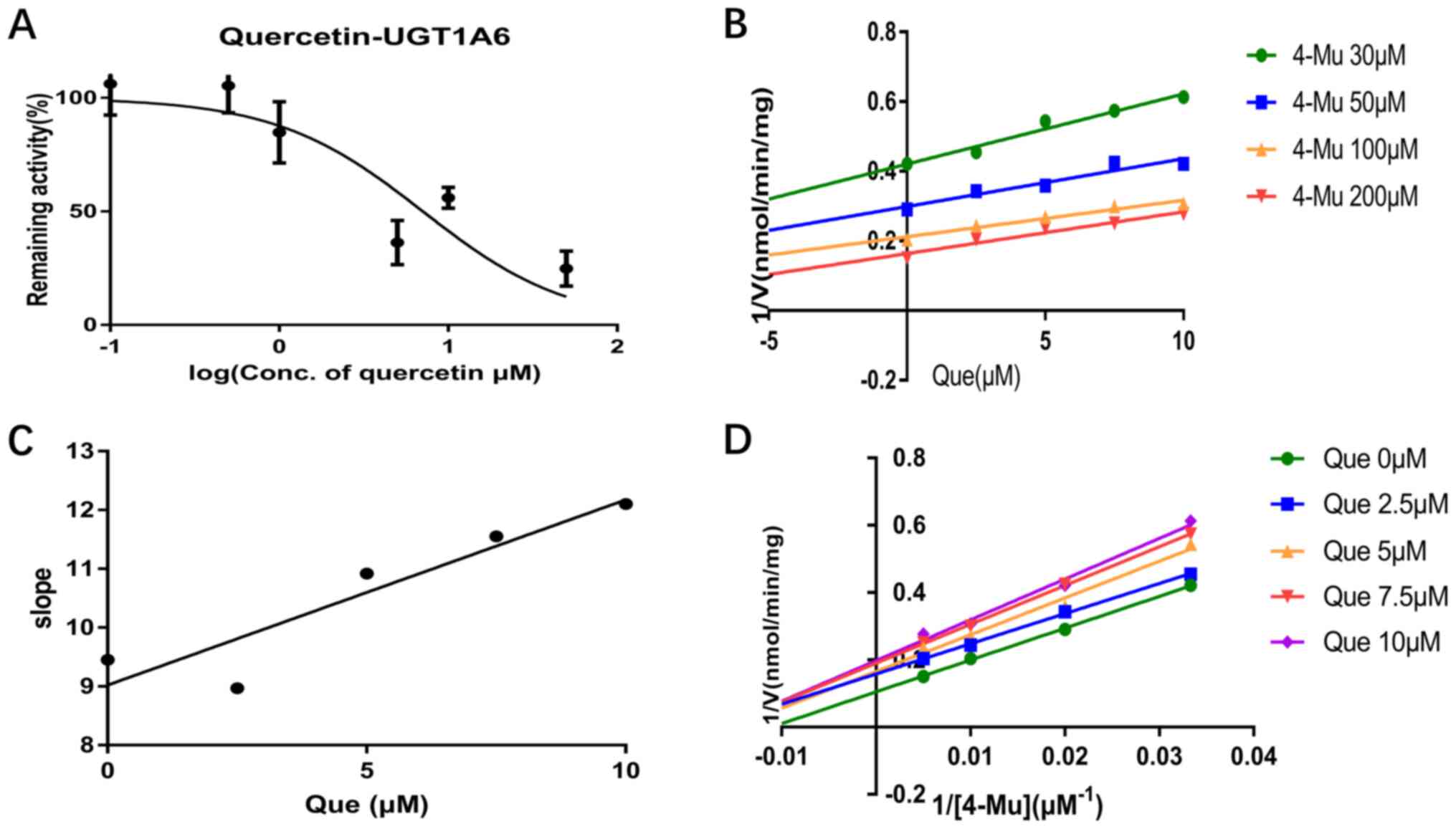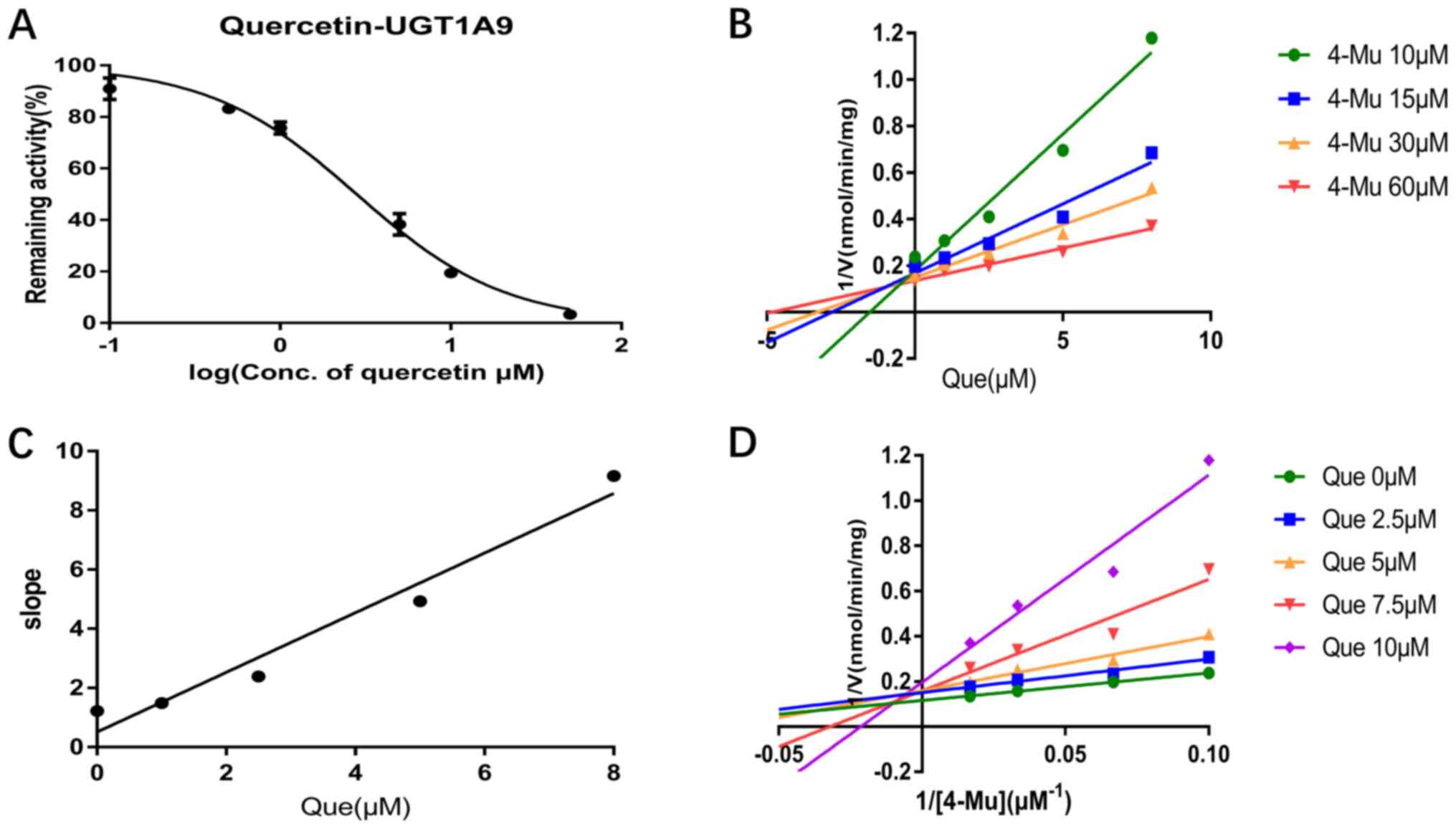|
1
|
Babaei F, Mirzababaei M and Nassiri-Asl M:
Quercetin in food: Possible mechanisms of its effect on memory. J
Food Sci. 83:2280–2287. 2018.PubMed/NCBI View Article : Google Scholar
|
|
2
|
Costa LG, Garrick JM, Roque PJ and
Pellacani C: Mechanisms of neuroprotection by quercetin:
Counteracting oxidative stress and more. Oxid Med Cell Longev.
2016(2986796)2016.PubMed/NCBI View Article : Google Scholar
|
|
3
|
Jana N, Břetislav G, Pavel S and Pavla U:
Potential of the flavonoid quercetin to prevent and treat
cancer-current status of research. Klin Onkol. 31:184–190.
2018.PubMed/NCBI View Article : Google Scholar
|
|
4
|
Primikyri A, Sayyad N, Quilici G, Vrettos
EI, Lim K, Chi SW, Musco G, Gerothanassis IP and Tzakos AG: Probing
the interaction of a quercetin bioconjugate with Bcl-2 in living
human cancer cells with in-cell NMR spectroscopy. FEBS Lett.
592:3367–3379. 2018.PubMed/NCBI View Article : Google Scholar
|
|
5
|
Sharmila G, Athirai T, Kiruthiga B,
Senthilkumar K, Elumalai P, Arunkumar R and Arunakaran J:
Chemopreventive effect of quercetin in MNU and testosterone induced
prostate cancer of sprague-dawley rats. Nutr Cancer. 66:38–46.
2014.PubMed/NCBI View Article : Google Scholar
|
|
6
|
Tang SH, Li R, Tan J, Wang Y and Jiang ZT:
One pot synthesis of water-soluble quercetin derived
multifunctional nanoparticles with photothermal and antioxidation
capabilities. Colloids Surf B Biointerfaces.
183(110429)2019.PubMed/NCBI View Article : Google Scholar
|
|
7
|
Zheng YZ, Deng G, Liang Q, Chen DF, Guo R
and Lai RC: Antioxidant activity of quercetin and its glucosides
from propolis: A theoretical study. Sci Rep. 7(7543)2017.PubMed/NCBI View Article : Google Scholar
|
|
8
|
Newton K and Dixit VM: Signaling in innate
immunity and inflammation. Cold Spring Harb Perspect Biol.
4(a006049)2012.PubMed/NCBI View Article : Google Scholar
|
|
9
|
Byun EB, Yang MS, Choi HG, Sung NY, Song
DS, Sin SJ and Byun EH: Quercetin negatively regulates TLR4
signaling induced by lipopolysaccharide through tollip expression.
Biochem Biophys Res Commun. 431:698–705. 2013.PubMed/NCBI View Article : Google Scholar
|
|
10
|
Lee SM, Moon J, Chung JH, Cha YJ and Shin
MJ: Effect of quercetin-rich onion peel extracts on arterial
thrombosis in rats. Food Chem Toxicol. 57:99–105. 2013.PubMed/NCBI View Article : Google Scholar
|
|
11
|
Pan W, Chang MJ, Booyse FM, Grenett HE,
Bradley KM, Wolkowicz PE, Shang Q and Tabengwa EM: Quercetin
induced tissue-type plasminogen activator expression is mediated
through Sp1 and p38 mitogen-activated protein kinase in human
endothelial cells. J Thromb Haemost. 6:976–985. 2008.PubMed/NCBI View Article : Google Scholar
|
|
12
|
Qiu X, Kroeker A, He S, Kozak R, Audet J,
Mbikay M and Chrétien M: Prophylactic efficacy of quercetin
3-β-O-d-glucoside against ebola virus infection. Antimicrob Agents
Chemother. 60:5182–5188. 2016.PubMed/NCBI View Article : Google Scholar
|
|
13
|
Gonzalez O, Fontanes V, Raychaudhuri S,
Loo R, Loo J, Arumugaswami V, Sun R, Dasgupta A and French SW: The
heat shock protein inhibitor quercetin attenuates hepatitis C virus
production. Hepatology. 50:1756–1764. 2009.PubMed/NCBI View Article : Google Scholar
|
|
14
|
Liu H, Guo X, Chu Y and Lu S: Heart
protective effects and mechanism of quercetin preconditioning on
anti-myocardial ischemia reperfusion (IR) injuries in rats. Gene.
545:149–155. 2014.PubMed/NCBI View Article : Google Scholar
|
|
15
|
Lin R, Liu J, Gan W and Ding C: Protective
effect of quercetin on the homocysteine-injured human umbilical
vein vascular endothelial cell line (ECV304). Basic Clin Pharmacol
Toxicol. 101:197–202. 2007.PubMed/NCBI View Article : Google Scholar
|
|
16
|
Kobori M, Takahashi Y, Sakurai M, Akimoto
Y, Tsushida T, Oike H and Ippoushi K: Quercetin suppresses immune
cell accumulation and improves mitochondrial gene expression in
adipose tissue of diet-induced obese mice. Mol Nutr Food Res.
60:300–312. 2016.PubMed/NCBI View Article : Google Scholar
|
|
17
|
Singh D, Tanwar H, Jayashankar B, Sharma
J, Murthy S, Chanda S, Singh SB and Ganju L: Quercetin exhibits
adjuvant activity by enhancing Th2 immune response in ovalbumin
immunized mice. Biomed Pharmacother. 90:354–360. 2017.PubMed/NCBI View Article : Google Scholar
|
|
18
|
Andres S, Pevny S, Ziegenhagen R, Bakhiya
N, Schäfer B, Hirsch-Ernst KI and Lampen A: Safety aspects of the
use of quercetin as a dietary supplement. Mol Nutr Food Res.
62:2018.PubMed/NCBI View Article : Google Scholar
|
|
19
|
Yang T, Liu Y, Huang X, Zhang R, Yang C,
Zhou J, Zhang Y, Wan J and Shi S: Quercetin-3-O-β-D-glucoside
decreases the bioavailability of cyclosporin A through regulation
of drug metabolizing enzymes, transporters and nuclear receptors in
rats. Mol Med Rep. 18:2599–2612. 2018.PubMed/NCBI View Article : Google Scholar
|
|
20
|
Baral S, Pariyar R, Kim J, Lee HS and Seo
J: Quercetin-3-O-glucuronide promotes the proliferation and
migration of neural stem cells. Neurobiol Aging. 52:39–52.
2017.PubMed/NCBI View Article : Google Scholar
|
|
21
|
Li F, Sun XY, Li XW, Yang T and Qi LW:
Enrichment and separation of quercetin-3-O-β-d-glucuronide from
lotus leaves (nelumbo nucifera gaertn.) and evaluation of its
anti-inflammatory effect. J Chromatogr B Analyt Technol Biomed Life
Sci. 1040:186–191. 2017.PubMed/NCBI View Article : Google Scholar
|
|
22
|
Oliveira EJ and Watson DG: In vitro
glucuronidation of kaempferol and quercetin by human UGT-1A9
microsomes. FEBS Lett. 471:1–6. 2000.PubMed/NCBI View Article : Google Scholar
|
|
23
|
Zhou H, Shi R, Ma B, Ma Y, Wang C, Wu D,
Wang X and Cheng N: CYP450 1A2 and multiple UGT1A isoforms are
responsible for jatrorrhizine metabolism in human liver microsomes.
Biopharm Drug Dispos. 34:176–185. 2013.PubMed/NCBI View
Article : Google Scholar
|
|
24
|
Stingl JC, Bartels H, Viviani R, Lehmann
ML and Brockmöller J: Relevance of UDP-glucuronosyltransferase
polymorphisms for drug dosing: A quantitative systematic review.
Pharmacol Ther. 141:92–116. 2014.PubMed/NCBI View Article : Google Scholar
|
|
25
|
Miners JO, Mackenzie PI and Knights KM:
The prediction of drug-glucuronidation parameters in humans:
UDP-glucuronosyltransferase enzyme-selective substrate and
inhibitor probes for reaction phenotyping and in vitro-in vivo
extrapolation of drug clearance and drug-drug interaction
potential. Drug Metab Rev. 42:196–208. 2010.PubMed/NCBI View Article : Google Scholar
|
|
26
|
Jeong HU, Lee JY, Kwon SS, Kim JH, Kim YM,
Hong SW, Yeon SH, Lee SM, Cho YY and Lee HS: Metabolism-mediated
drug interaction potential of HS-23, a new herbal drug for the
treatment of sepsis in human hepatocytes and liver microsomes. Arch
Pharm Res. 38:171–177. 2015.PubMed/NCBI View Article : Google Scholar
|
|
27
|
Tan ML and Lim LE: The effects of
Andrographis paniculata (Burm.f.) Nees extract and diterpenoids on
the CYP450 isoforms' activities, a review of possible herb-drug
interaction risks. Drug Chem Toxicol. 38:241–253. 2015.PubMed/NCBI View Article : Google Scholar
|
|
28
|
Li G, Huang K, Nikolic D and van Breemen
RB: High-throughput cytochrome P450 cocktail inhibition assay for
assessing drug-drug and drug-botanical interactions. Drug Metab
Dispos. 43:1670–1678. 2015.PubMed/NCBI View Article : Google Scholar
|
|
29
|
Weissenstein U, Kunz M, Oufir M, Wang JT,
Hamburger M, Urech K, Regueiro U and Baumgartner S: Absence of
herb-drug interactions of mistletoe with the tamoxifen metabolite
(E/Z)-endoxifen and cytochrome P450 3A4/5 and 2D6 in vitro. BMC
Complement Altern Med. 19(23)2019.PubMed/NCBI View Article : Google Scholar
|
|
30
|
Tuteja S, Pyrsopoulos NT, Wolowich WR,
Khanmoradi K, Levi DM, Selvaggi G, Weisbaum G, Tzakis AG and Schiff
ER: Simvastatin-ezetimibe-induced hepatic failure necessitating
liver transplantation. Pharmacotherapy. 28:1188–1193.
2008.PubMed/NCBI View Article : Google Scholar
|
|
31
|
Magee CN, Medani SA, Leavey SF, Conlon PJ
and Clarkson MR: Severe rhabdomyolysis as a consequence of the
interaction of fusidic acid and atorvastatin. Am J Kidney Dis.
56:e11–e15. 2010.PubMed/NCBI View Article : Google Scholar
|
|
32
|
Huang T, Fang ZZ and Yang L: Strong
inhibitory effect of medroxyprogesterone acetate (MPA) on
UDP-glucuronosyltransferase (UGT) 2B7 might induce drug-drug
interactions. Pharmazie. 65:919–921. 2010.PubMed/NCBI
|
|
33
|
Lu H, Fang ZZ, Cao YF, Hu CM, Hong M, Sun
XY, Li H, Liu Y, Fu X and Sun H: Isoliquiritigenin showed strong
inhibitory effects towards multiple UDP-glucuronosyltransferase
(UGT) isoform-catalyzed 4-methylumbelliferone (4-MU)
glucuronidation. Fitoterapia. 84:208–212. 2013.PubMed/NCBI View Article : Google Scholar
|
|
34
|
Liu C, Cao YF, Fang ZZ, Zhang YY, Hu CM,
Sun XY, Huang T, Zeng J, Fan XR and Mo H: Strong inhibition of
deoxyschizandrin and schisantherin A toward
UDP-glucuronosyltransferase (UGT) 1A3 indicating UGT
inhibition-based herb-drug interaction. Fitoterapia. 83:1415–1419.
2012.PubMed/NCBI View Article : Google Scholar
|
|
35
|
Jiang HM, Fang ZZ, Cao YF, Hu CM, Sun XY,
Hong M, Yang L, Ge GB, Liu Y, Zhang YY, et al: New insights for the
risk of bisphenol A: Inhibition of UDP-glucuronosyltransferases
(UGTs). Chemosphere. 93:1189–1193. 2013.PubMed/NCBI View Article : Google Scholar
|
|
36
|
Sun D, Zhang CZ, Ran RX, Cao YF, Du Z, Fu
ZW, Huang CT, Zhao ZY, Zhang WH and Fang ZZ: In vitro comparative
study of the inhibitory effects of mangiferin and its aglycone
norathyriol towards UDP-glucuronosyl transferase (UGT) isoforms.
Molecules. 22(1008)2017.PubMed/NCBI View Article : Google Scholar
|
|
37
|
Zhu L, Ge G, Liu Y, He G, Liang S, Fang Z,
Dong P, Cao Y and Yang L: Potent and selective inhibition of
magnolol on catalytic activities of UGT1A7 and 1A9. Xenobiotica.
42:1001–1008. 2012.PubMed/NCBI View Article : Google Scholar
|
|
38
|
Miclaus MO, Filip X, Filip C, Martin FA
and Grosu IG: Highly sensitive solid forms discrimination on the
whole tablet of the active ingredients in quercetin dietary
supplements by NMR crystallography approaches. J Pharm Biomed Anal.
124:274–280. 2016.PubMed/NCBI View Article : Google Scholar
|
|
39
|
Shi S and Li Y: Interplay of
drug-metabolizing enzymes and transporters in drug absorption and
disposition. Curr Drug Metab. 15:915–941. 2014.PubMed/NCBI View Article : Google Scholar
|
|
40
|
Wu B: Pharmacokinetic interplay of phase
II metabolism and transport: A theoretical study. J Pharm Sci.
101:381–393. 2012.PubMed/NCBI View Article : Google Scholar
|
|
41
|
Zal F, Mostafavi-Pour Z and Vessal M:
Comparison of the effects of vitamin E and/or quercetin in
attenuating chronic cyclosporine A-induced nephrotoxicity in male
rats. Clin Exp Pharmacol Physiol. 34:720–724. 2007.PubMed/NCBI View Article : Google Scholar
|
|
42
|
Mostafavi-Pour Z, Zal F, Monabati A and
Vessal M: Protective effects of a combination of quercetin and
vitamin E against cyclosporine A-induced oxidative stress and
hepatotoxicity in rats. Hepatol Res. 38:385–392. 2008.PubMed/NCBI View Article : Google Scholar
|
|
43
|
Liu Y, Luo X, Yang C, Yang T, Zhou J and
Shi S: Impact of quercetin-induced changes in drug-metabolizing
enzyme and transporter expression on the pharmacokinetics of
cyclosporine in rats. Mol Med Rep. 14:3073–3085. 2016.PubMed/NCBI View Article : Google Scholar
|
|
44
|
Stachel N and Skopp G: Formation and
inhibition of ethyl glucuronide and ethyl sulfate. Forensic Sci
Int. 265:61–64. 2016.PubMed/NCBI View Article : Google Scholar
|
|
45
|
van de Kerkhof EG, de Graaf IA, Ungell AL
and Groothuis GM: Induction of metabolism and transport in human
intestine: Validation of precision-cut slices as a tool to study
induction of drug metabolism in human intestine in vitro. Drug
Metab Dispos. 36:604–613. 2008.PubMed/NCBI View Article : Google Scholar
|
|
46
|
Galijatovic A, Walle UK and Walle T:
Induction of UDP-glucuronosyltransferase by the flavonoids chrysin
and quercetin in Caco-2 cells. Pharm Res. 17:21–26. 2000.PubMed/NCBI View Article : Google Scholar
|
|
47
|
van der Logt EM, Roelofs HM, Nagengast FM
and Peters WH: Induction of rat hepatic and intestinal
UDP-glucuronosyltransferases by naturally occurring dietary
anticarcinogens. Carcinogenesis. 24:1651–1656. 2003.PubMed/NCBI View Article : Google Scholar
|
|
48
|
Bolling BW, Court MH, Blumberg JB and Chen
CY: Microsomal quercetin glucuronidation in rat small intestine
depends on age and segment. Drug Metab Dispos. 39:1406–1414.
2011.PubMed/NCBI View Article : Google Scholar
|
|
49
|
Kawai Y, Nishikawa T, Shiba Y, Saito S,
Murota K, Shibata N, Kobayashi M, Kanayama M, Uchida K and Terao J:
Macrophage as a target of quercetin glucuronides in human
atherosclerotic arteries: Implication in the anti-atherosclerotic
mechanism of dietary flavonoids. J Biol Chem. 283:9424–9434.
2008.PubMed/NCBI View Article : Google Scholar
|
|
50
|
Ishizawa K, Yoshizumi M, Kawai Y, Terao J,
Kihira Y, Ikeda Y, Tomita S, Minakuchi K, Tsuchiya K and Tamaki T:
Pharmacology in health food: Metabolism of quercetin in vivo and
its protective effect against arteriosclerosis. J Pharmacol Sci.
115:466–470. 2011.PubMed/NCBI View Article : Google Scholar
|
|
51
|
Chao CL, Hou YC, Chao PD, Weng CS and Ho
FM: The antioxidant effects of quercetin metabolites on the
prevention of high glucose-induced apoptosis of human umbilical
vein endothelial cells. Brit J Nutr. 101:1165–1170. 2009.PubMed/NCBI View Article : Google Scholar
|
|
52
|
Senafi SB, Clarke DJ and Burchell B:
Investigation of the substrate specificity of a cloned expressed
human bilirubin UDP-glucuro-nosyltransferase: UDP-sugar specificity
and involvement in steroid and xenobiotic glucuronidation. Biochem
J. 303:233–240. 1994.PubMed/NCBI View Article : Google Scholar
|
|
53
|
Boersma MG, van der Woude H, Bogaards J,
Boeren S, Vervoort J, Cnubben NH, van Iersel ML, van Bladeren PJ
and Rietjens IM: Regioselectivity of phase II metabolism of
luteolin and quercetin by UDP-glucuronosyl transferases. Chem Res
Toxicol. 15:662–670. 2002.PubMed/NCBI View Article : Google Scholar
|















